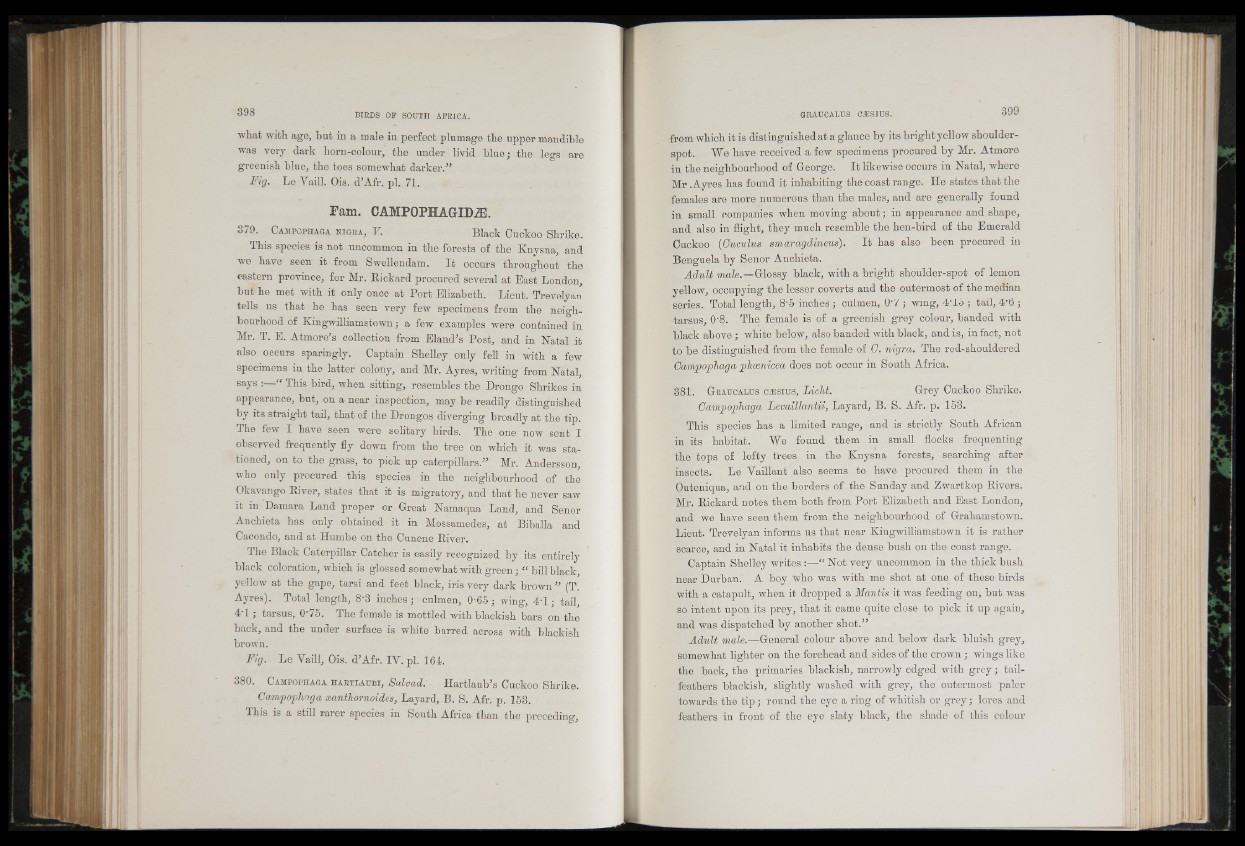
what with age, but in a male in perfect plumage the upper mandible
was very dark horn-colour, the under livid blue; the legs are
greenish blue, the toes somewhat darker/'
Fig. Le Vaill. Ois. d’Afr. pi. 71.
Fam. CAMPOPHAGIDJE.
379. C a m p o p h a g a n i g r a , V. Black Cuckoo Shrike.
This species is not uncommon in the forests of the Knysna, and
we have seen it from Swellendam. I t occurs throughout the
eastern province, for Mr. Rickard procured several at Bast London,
but he met with it only once at Port Elizabeth. Lieut. Trevelyan
tells us that he has seen very few specimens from the neighbourhood
of Kingwilliamstown; a few examples were contained in
Mr. T. E. Atmore’s collection from Eland's Post, and in Natal it
also occurs sparingly. Captain Shelley only fell in with a few
specimens in the latter colony, and Mr. Ayres, writing from Natal,
says :—“ This bird, when sitting, resembles the Drongo Shrikes in
appearance, but, on a near inspection, may be readily distinguished
by its straight tail, that of the Drongos diverging broadly at the tip.
The few I have seen were solitary birds. The one now sent I
observed frequently fly down from the tree on which it was stationed,
on to the grass, to pick up caterpillars." Mr. Andersson,
who only procured this species in the neighbourhood of the
Okavango River, states that it is migratory, and that he never saw
it in Damara Land proper or Great Namaqua Land, and Senor
Anchieta has only obtained it in Mossamedes, at Biballa and
Cacondo, and at Humbe on the Cunene River.
The Black Caterpillar Catcher is easily recognized by its entirely
black coloration, which is glossed somewhat with green; “ bill black,
yellow at the gape, tarsi and feet black, iris very dark brown " (T.
Ayres). Total length, 8'3 inches; culmen, 0-65; wing, 4-1; tail,
4-1; tarsus, Q‘75. The female is mottled with blackish bars on the
back, and the under surface is white barred across with blackish
brown.
Fig. Le Vaill, Ois. d’Afr. IV. pi. 164.
380. C a m p o p h a g a h a r t l a u b i , Salvad. Hartlaub’s Cuckoo Shrike.
Campophaga xanthornoides, Layard, B. S. Afr. p. 153.
This is a still rarer species in South Africa than the preceding,
from which it is distinguished at a glance by its brightyellow shoulder-
spot. We have received a few specimens procured by Mr. Atmore
in the neighbourhood of George. It likewise occurs in Natal, where
Mr .Ayres has found it inhabiting the coast range. He states that the
females are more numerous than the males, and are generally found
in small companies when moving about; in appearance and shape,
and also in flight, they much resemble the hen-bird of the Emerald
Cuckoo (Cuculus smardgdineus). It has also been procured in
Benguela by Senor Anchieta.
Adult male.—Glossy black, with a bright shoulder-spot of lemon
yellow, occupying the lesser coverts and the outermost of the median
series. Total length, 8-5 inches; culmen, 0*7; wing, 4'15 ; tail, 4’6 ;
tarsus, 0‘8. The female is of a greenish grey colour, banded with
black above ; white below, also banded with black, and is, in fact, not
to be distinguished from the female of C. nigra. The red-shouldered
Campophaga phoenicea does not occur in South Africa.
381. Graucalus C-esius, Liclit. ' Grey Cuckoo Shrike.
Campophaga Levaillantn, Layard, B. S. Afr. p. 153.
This species has a limited range, and is strictly South African
in its habitat. We found them in small flocks frequenting
the tops of lofty trees in the Knysna forests, searching after
insects. Le Vaillant also seems to have procured them in the
Outeniqua, and on the borders of the Sunday and Zwartkop Rivers.
Mr. Rickard notes them both from Port Elizabeth and East London,
and we have seen them from , the neighbourhood of Grahamstown.
Lieut. Trevelyan informs us that near Kingwilliamstown it is rather
scarce, and in Natal it inhabits the dense bush on the coast range.
Captain Shelley writes “ Not very uncommon in the thick bush
near Durban. A boy who was with me shot at one of these birds
with a catapult, when it dropped a Mantis it was feeding on, but was
so intent upon its prey, that it came quite close to pick it up again,
and was dispatched by another shot."
Adult male.—General colour above and below dark bluish grey,
somewhat lighter on the forehead and sides of the crown ; wings like
the back, the primaries blackish, narrowly edged with grey; tail-
feathers blackish, slightly washed with grey, the outermost paler
towards the tip ; round the eye a ring of whitish or grey; lores and
feathers in front of the eye slaty black, the shade of this colour